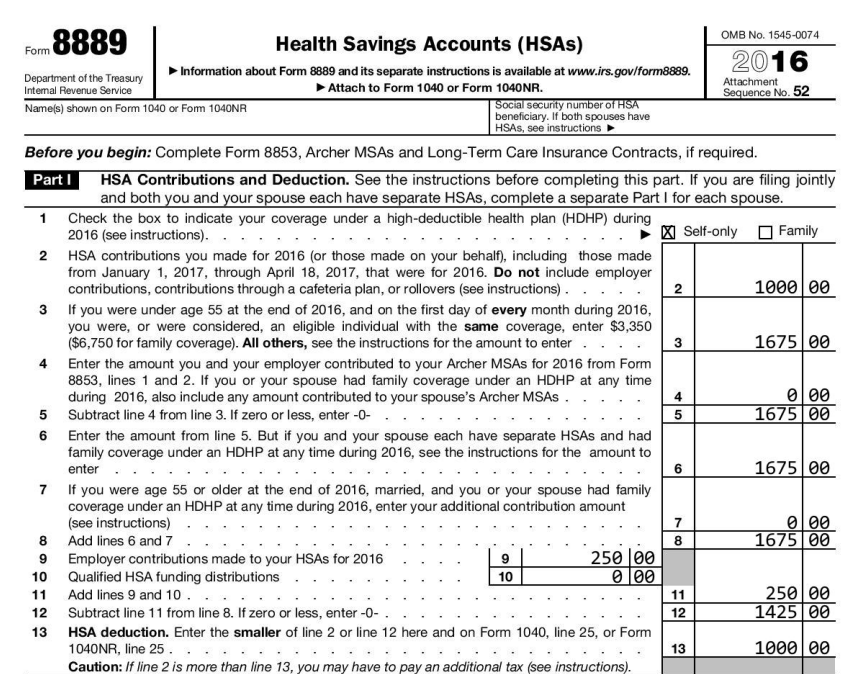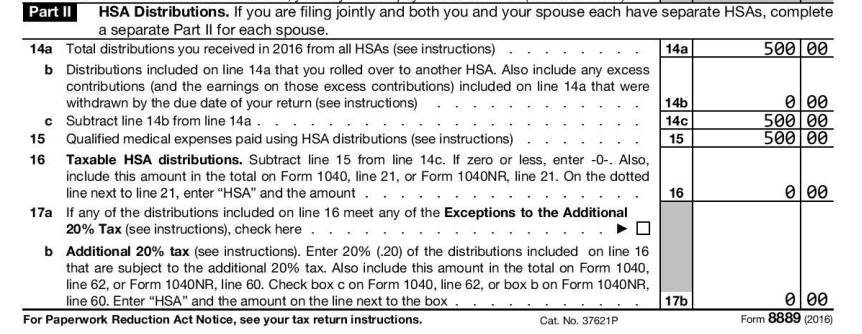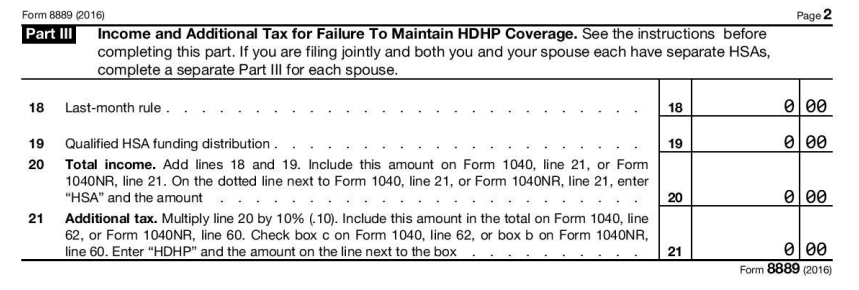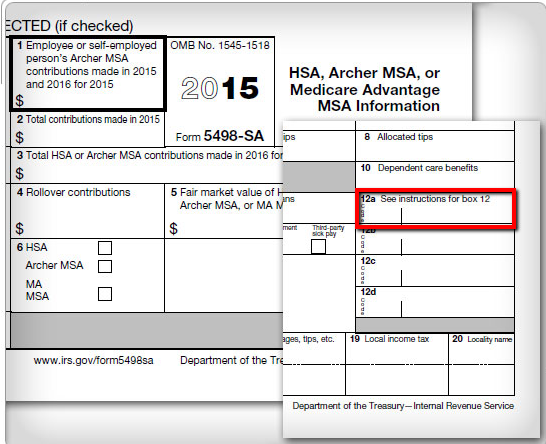As tax season for 2016 falls upon us, the IRS has released the 2016 version of Form 8889, the official form for HSA tax reporting. Notably, as of January 15th, the 2016 HSA Form 8889 instructions have not been released. However, you should be able to get by with the 2015 instructions – just keeping in mind that a few contribution maximums have changed.
I have created the following video to walk through changes and an example for 2016’s Form 8889. Check it out, otherwise, the transcription of the information is below.
Watch on Youtube: HSA Last Month Rule and Testing Period
In the following article we will cover:
- Changes to 2016 Form 8889
- 2016 HSA Contribution Limits
- 2016 HDHP Definitions
- 2016 Form 8889 instructions and example
Changes to 2016 Form 8889 tax form
For those of you who have filed HSA taxes before, you won’t notice much change in the 2016 version of Form 8889. Obviously the tax year of the form has incremented, so just verify you have the correct form which says “2016” in the upper right hand corner. The main difference reflects the maximum contribution limit increase for family coverage, from $6,650 to $6,750. This is indicated on Line 3 which is used to determine your contribution limit. It is assumed that when the IRS updates the 2016 instructions, they will include this update in the calculations for more complicated (e.g. partial year coverage) situations, which are explained there.

Pretty minor, but you will also notice year updates throughout the form. For example, you see this in “Part II – HSA Distributions” section, where in Line 14a they state that we are concerned about distributions occurring in tax year 2016:

There were also some changes to HDHP definitions in 2016 so read on if those apply to you.
Changes to 2016 Form 8889 instructions
At this point the 2016 Form 8889 instructions have not been released, but we will check for changes in methodology once they are available.
2016 HSA Contribution Limits
For family coverage, the maximum contribution limit increased by $100 to $6,750 in 2016. The IRS defines the maximum amounts that may be contributed to a Health Savings Account each year. Per IRS Publication 969, the 2016 HSA contribution limits are:
The amount you or any other person can contribute to your HSA depends on the type of HDHP coverage you have, your age, the date you became an eligible individual, and the date you cease to be an eligible individual…for 2016, if you have self-only HDHP coverage, you can contribute up to $3,350. If you have family HDHP coverage you can contribute up to $6,750.
Here are HSA contribution limits for years 2014, 2015, 2016, and now 2017 since it has been released:
| 2014 | 2015 | 2016 | 2017 | |
| Self-Only HSA Contribution Limit | $3,300 | $3,350 | $3,350 | $3,400 |
| Family HSA Contribution Limit | $6,550 | $6,650 | $6,750 | $6,750 |
| 55+ Additional Contribution Limit | +$1,000 | +$1,000 | +$1,000 | +$1,000 |
So the cap or maximum contribution amount to your HSA is $3,350 for self-only coverage and $6,750 for family coverage in 2016. Note that this does not include the additional 55+ catch up contribution of $1,000 allowed to properly aged HSA holders. Thus, if you are over 55 on or before the end of 2016, you can contribute $4,350 for self-only coverage or $7,750 for family coverage.
2016 HDHP Definitions
To qualify as an HDHP, your health plan cannot exceed an out-of-pocket maximum limit established by the IRS. For 2016, the out-of-pocket max was increased for both self-only and family coverage. Self-only increased $100 to $6,550 while family increased $200 to $13,100. Plans with an out-of-pocket max that exceeds these amounts are not HSA eligible. The IRS defines what constitutes an HDHP (High Deductible Health Plan), which is a prerequisite for contributing to an HSA. Again, you can see the HDHP definitions in IRS Publication 969 for 2016. The HDHP definitions for 2014, 2015, 2016, and 2017 (because they are now available) are summarized below:
| 2014 | 2015 | 2016 | 2017 | |
| Self-Only Min Deductible | $1,250 | $1,300 | $1,300 | $1,300 |
| Self-Only OOP Max | $6,350 | $6,450 | $6,550 | $6,550 |
| Family Min Deductible | $2,500 | $2,600 | $2,600 | $2,600 |
| Family OOP max | $12,700 | $12,900 | $13,100 | $13,100 |
2016 HSA Form 8889 example
Let’s walk through an example of the 2016 Form 8889 to show how it works.
Let’s assume I am a 30 year old who had self-only, HSA eligible coverage from January – June of 2016 (6 months). On July 1st, I changed to a non-HSA eligible plan. I contributed $1000 to my HSA and my employer contributed $250. I distributed $500 from the HSA during the year, all of which I spent on qualified medical expenses.
Part I – Contributions and Deduction
Form 8889 starts off pretty simply on Line 1 by asking the type of insurance you had (mostly) during the year. For this example, it is self-only. Line 2 then goes on to ask how much you contributed to your HSA during the year. In our case this was $1000, which does not include employer contributions. Line 3 can be quite complicated, but in essence you need to list your contribution limit for the year. If you had self-only or family coverage all year, the amounts are provided for you. Otherwise, you need to prorate your coverage by month. In this case, we had self-only coverage for 6 months, so our contribution limit is $1,675 for 2016. Line 4 asks about Archer MSA’s (does not apply here) and Line 5 is a simple subtraction.
[Note: all 2016 tax forms were generated in minutes using EasyForm8889.com]

We continue with Line 6, which for self-only filers is just Line 5, but family filers where both spouses have HSA’s have the option to distribute part of their contribution limit to each account. For some situations, Line 7 adds the $1,000 catch up contribution, but our example assumes the HSA holder is 30 years old so this does not apply. Line 8 is simple subtraction, and the $250 employer contribution comes into play on Line 9. If you contributed to your HSA from an IRA you would indicate that on Line 10, and Line 11 is simple addition. Line 12 is subtraction, and Line 13 does a comparison to calculate what your 2016 HSA deduction is, which makes its way to Form 1040. In our case, it is the $1,000 we contributed to the HSA.
Part II – Distributions
The second part of the 2016 Form 8889 deals with distributions, or amounts that came out of your HSA. We assume that we distributed $500 from the HSA, so that amount is shown on Line 14a. Line 14b lists rollover amounts and excess contributions removed, and Line 14c subtracts them out. The filer tracked his qualified medical expenses and receipts using TrackHSA.com this year, so he can easily prove all $500 were legit and puts that value in Line 15. A subtraction occurs on Line 16 to determine any amounts not spent on qualified medical expenses; luckily that is $0 for us. If you had an amount on Line 16, Line 17a gives you the chance to exclude this from taxation. Otherwise, that Line 16 amount is taxed 20% on Line 17b, which gets recorded on Form 1040.

Part III – Penalties and Taxes
For most people, Part III will look a lot below: all zeroes. This is good, but it is possible that you have accrued some taxes and penalties. If in the prior tax year, you 1) used the Last Month Rule and proceeded to 2) fail its Testing Period, a difficult calculation awaits you on Line 18. You are going to have to go back, figure out how much you contributed in the prior year, redetermine what you could have contributed, and place the difference here. On a similar note, if you made a qualified funding distribution from your IRA but failed its Testing Period, you will have to enter the amount that failed in Line 19. Once that is done, Line 20 adds Line 18 and Line 19 and adds it back to income (where it is taxed) on Form 1040. Finally, for good measure, Line 21 assesses a 10% penalty against the amount on Line 20, which also makes its way to Form 1040.

————————————
Note: if you have an HSA, please consider trying my service TrackHSA.com for your Health Savings Account record keeping. You can store purchases, receipts, and reimbursements securely online in the cloud.







